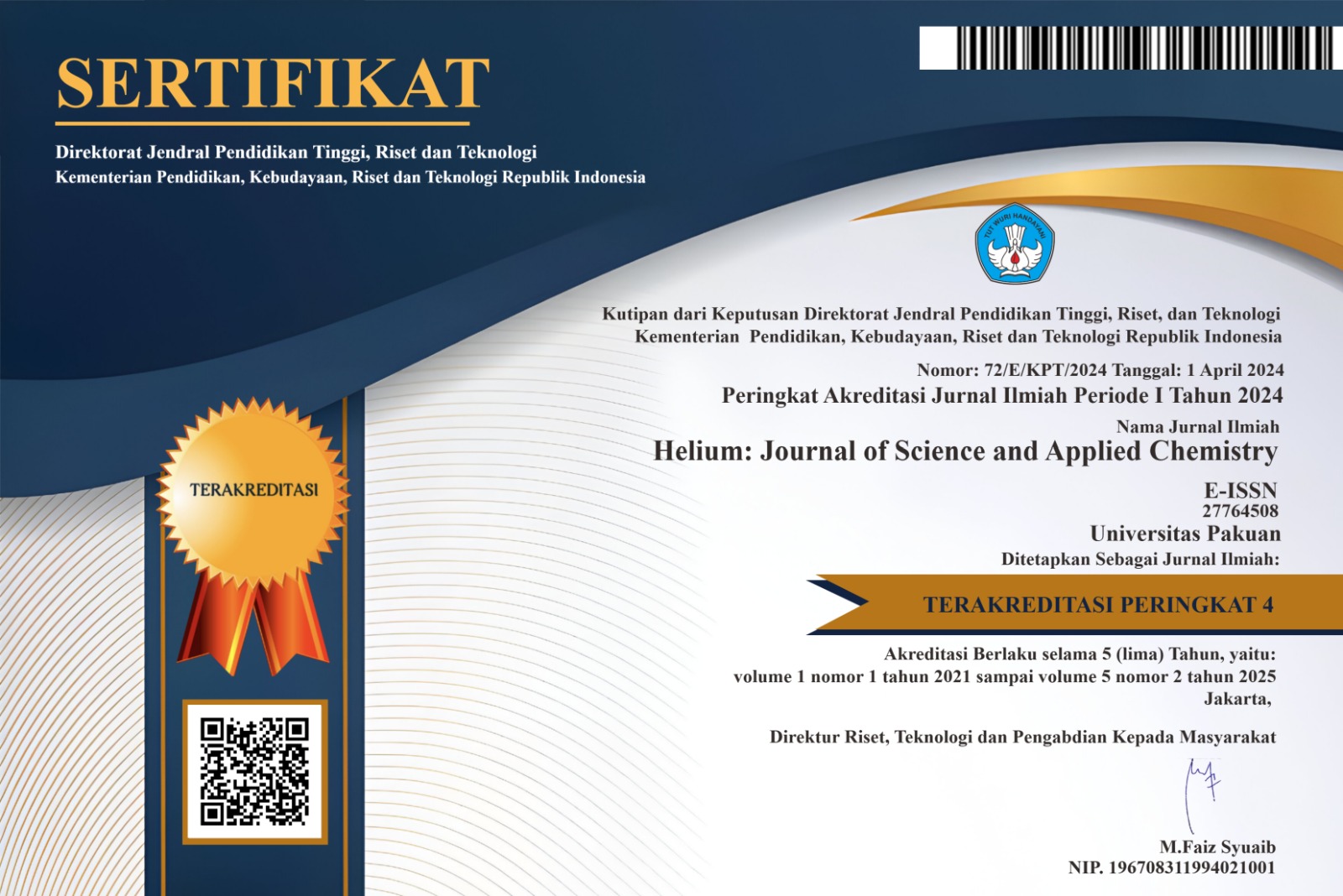The Effect of Ethanol Polarities on Tannin Content of Persea americana Mill Seeds Extract Using Gelatin Precipitation Method
DOI:
https://doi.org/10.33751/helium.v4i2.10Keywords:
Ethanol, Gelatin, Persea americana, Tannin, PolarityAbstract
Persea americana Mill (avocado) seed waste contains tannin compounds with several benefits and high economic value. Tannin is a natural compound widely used in various industries, including the pharmaceutical industry. The difference in concentration of ethanol causes polarity differences. This research aims to determine the effectiveness of tannin extraction from avocado seed using different concentration polarities of ethanol as a solvent. The dry powder of avocado seed was macerated in ethanol at concentrations of 30, 50, 70, and 96% for 72 hours, respectively. The gelatin precipitation method was applied to determine the tannin content in each extract; absorbance was read using a spectrophotometer UV-Vis, and the Folin Ciocalteu reagent was added to the avocado seed extract before spectrophotometer measurement. The results show that the polarity of ethanol has a significant effect (p<0.05) on the yield extract and tannin level in each extract. The extract yield and tannin content in avocado seed extracted with 30, 50,70 and 96% ethanol were 21.47%, 26.70%, 30.40%, and 47.67%, while the tannin content was 32.27 mg/g, 50.58 mg/g, 60.94 mg/g, and 85.30 mg/g respectively. The highest extract yield and tannin content are found in avocado seed extracted with 96% ethanol, which has lower polarity. It can be concluded that 96% ethanol is the best solvent to extract tannin from avocado seeds.
References
M. C. García-Vargas, M. D. M. Contreras, I. Gómez-Cruz, J. M. Romero-García, and E. Castro, “Avocado-Derived Biomass: Chemical Composition and Antioxidant Potential,” in The 1st International Electronic Conference on Food Science and Functional Foods, MDPI, Nov. 2020, p. 100. doi: 10.3390/foods_2020-07750.
C. Anwar, I. Irhami, and I. R. Aprita, “The Potency of Avocado Seeds (”Persea Americana” Mill.) as a Source of Antioxidant Tea,” FWIAFE, pp. 131–144, Jun. 2022, doi: 10.31926/but.fwiafe.2022.15.64.1.10.
H. Y. Setyawan, S. Sukardi, and C. A. Puriwangi, “Phytochemicals properties of avocado seed: A review,” IOP Conf. Ser.: Earth Environ. Sci., vol. 733, no. 1, p. 012090, Apr. 2021, doi: 10.1088/1755-1315/733/1/012090.
O. Omorevbarhia, S. C. Umerie, E. L. Aniefuna, and O. C. Enoch, “Proximate, Phytochemical and Mineral Composition of Methanol Extract of Persea americana Seed,” IJBcRR, vol. 32, no. 2, pp. 1–9, Mar. 2023, doi: 10.9734/ijbcrr/2023/v32i2797.
S. P. Bangar et al., “Avocado seed discoveries: Chemical composition, biological properties, and industrial food applications,” Food Chemistry: X, vol. 16, p. 100507, Dec. 2022, doi: 10.1016/j.fochx.2022.100507.
K. Kupnik, M. Primožič, V. Kokol, Ž. Knez, and M. Leitgeb, “Enzymatic, Antioxidant, and Antimicrobial Activities of Bioactive Compounds from Avocado (Persea americana L.) Seeds,” Plants, vol. 12, no. 5, p. 1201, Mar. 2023, doi: 10.3390/plants12051201.
C.-P. T. Soledad, H.-C. Paola, O.-V. Carlos Enrique, R.-L. I. Israel, N.-M. GuadalupeVirginia, and Á.-S. Raúl, “Avocado seeds (Persea americana cv. Criollo sp.): Lipophilic compounds profile and biological activities,” Saudi Journal of Biological Sciences, vol. 28, no. 6, pp. 3384–3390, Jun. 2021, doi: 10.1016/j.sjbs.2021.02.087.
M. I. Alkhalaf, W. S. Alansari, E. A. Ibrahim, and M. E. A. ELhalwagy, “Anti-oxidant, anti-inflammatory and anti-cancer activities of avocado (Persea americana) fruit and seed extract,” Journal of King Saud University - Science, vol. 31, no. 4, pp. 1358–1362, Oct. 2019, doi: 10.1016/j.jksus.2018.10.010.
B. Rodríguez-Martínez, A. Romaní, G. Eibes, G. Garrote, B. Gullón, and P. G. Del Río, “Potential and prospects for utilization of avocado by-products in integrated biorefineries,” Bioresource Technology, vol. 364, p. 128034, Nov. 2022, doi: 10.1016/j.biortech.2022.128034.
A. K. Das, Md. N. Islam, Md. O. Faruk, Md. Ashaduzzaman, and R. Dungani, “Review on tannins: Extraction processes, applications and possibilities,” South African Journal of Botany, vol. 135, pp. 58–70, Dec. 2020, doi: 10.1016/j.sajb.2020.08.008.
A. Pizzi, “Tannins medical/pharmacological and related applications: A critical review,” Sustainable Chemistry and Pharmacy, vol. 22, p. 100481, Sep. 2021, doi: 10.1016/j.scp.2021.100481.
K. Lumo Awaga, K. Mawuéna Novidzro, B. Kpensaga, K. Apeti Gbogbo, and E. Kossi Honoré Koumaglo, “Contribution to Phytotherapy Valorization of the Seed of Avocado, Persea Americana” AJBLS, Sep. 2023, doi: 10.11648/j.ajbls.20231105.12.
T. Lefebvre, E. Destandau, and E. Lesellier, “Selective extraction of bioactive compounds from plants using recent extraction techniques: A review,” Journal of Chromatography A, vol. 1635, p. 461770, Jan. 2021, doi: 10.1016/j.chroma.2020.461770.
M. Rahman et al., “Journal of Pharmacognosy and Phytochemistry,” vol. 1, no. 6, 2013.
T. Czaja, A. Sobota, and R. Szostak, “Quantification of Ash and Moisture in Wheat Flour by Raman Spectroscopy,” Foods, vol. 9, no. 3, p. 280, Mar. 2020, doi: 10.3390/foods9030280.
J. R. Shaikh and M. Patil, “Qualitative tests for preliminary phytochemical screening: An overview,” Int. J. Chem. Stud., vol. 8, no. 2, pp. 603–608, Mar. 2020, doi: 10.22271/chemi.2020.v8.i2i.8834.
Azwanida, NN, “A Review on the Extraction Methods Use in Medicinal Plants, Principle, Strength and Limitation,” Med Aromat Plants, vol. 04, no. 03, 2015, doi: 10.4172/2167-0412.1000196.
O. R. Alara, N. H. Abdurahman, and C. I. Ukaegbu, “Extraction of phenolic compounds: A review,” Current Research in Food Science, vol. 4, pp. 200–214, 2021, doi: 10.1016/j.crfs.2021.03.011.
A. Antony and M. Farid, “Effect of Temperatures on Polyphenols during Extraction,” Applied Sciences, vol. 12, no. 4, p. 2107, Feb. 2022, doi: 10.3390/app12042107.
A. Sridhar, M. Ponnuchamy, P. S. Kumar, A. Kapoor, D.-V. N. Vo, and S. Prabhakar, “Techniques and modeling of polyphenol extraction from food: a review,” Environ Chem Lett, vol. 19, no. 4, pp. 3409–3443, Aug. 2021, doi: 10.1007/s10311-021-01217-8.
C. Imoisi and U. C. Michael, “Comparative Physicochemical and Proximate Analyses of Different Extracts of Persea americana,” JCSN, vol. 45, no. 6, Oct. 2020, doi: 10.46602/jcsn.v45i6.539.
M. Siol and A. Sadowska, “Chemical Composition, Physicochemical and Bioactive Properties of Avocado (Persea americana) Seed and Its Potential Use in Functional Food Design,” Agriculture, vol. 13, no. 2, p. 316, Jan. 2023, doi: 10.3390/agriculture13020316.
E. Sri Sulasmi, M. Saptasari, K. Mawaddah, and F. Ama Zulfia, “Tannin Identification of 4 Species Pterydophyta from Baluran National Park,” J. Phys.: Conf. Ser., vol. 1241, no. 1, p. 012002, Jun. 2019, doi: 10.1088/1742-6596/1241/1/012002.
I. G. Munteanu and C. Apetrei, “Analytical Methods Used in Determining Antioxidant Activity: A Review,” IJMS, vol. 22, no. 7, p. 3380, Mar. 2021, doi: 10.3390/ijms22073380.
Crnkic Mirsad and Klepo Lejla, “Spectrophotometric Evaluation of Tannin Content in Domestic Beer Samples with Fe(III) and 1,10-Phenanthroline,” JPP, vol. 8, no. 1, Jan. 2020, doi: 10.17265/2328-2150/2020.01.002.
C. Peña, K. De La Caba, A. Eceiza, R. Ruseckaite, and I. Mondragon, “Enhancing water repellence and mechanical properties of gelatin films by tannin addition,” Bioresource Technology, vol. 101, no. 17, pp. 6836–6842, Sep. 2010, doi: 10.1016/j.biortech.2010.03.112.
S. Velavan, “P.G. and Research Department of Biochemistry, Maruthupandiyar College, Thanjavur, Tamil Nadu, S. India Harman Institute of Science Education and Research, Thanjavur, Tamil Nadu, S. India.
Downloads
Published
How to Cite
Issue
Section
License
Copyright (c) 2025 Helium: Journal of Science and Applied Chemistry

This work is licensed under a Creative Commons Attribution-NonCommercial-ShareAlike 4.0 International License.













